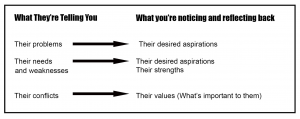Catalytic Listening is a way of listening that brings out the best in ourselves and others.
In our daily interactions, people often talk about problems and worries. When we, as the listeners, also focus on those problems – perhaps giving advice or taking sides – we are creating a loop that keeps both parties in that negative mode. (If you are curious about the brain science of that loop, this short video provides an introduction.)
When instead we listen for what is powerful and what is possible, we create a different loop – a path to their potential and their wisdom.
- They are able to focus on the things that are most important to them
- They are able to answer their own questions and problems, rooted in their own wisdom and experience
Catalytic Listening is therefore about what we notice when we are focused on the other person’s potential. To do so, first we must slow down and be present with that other person, quieting our own mind as the listener. From there, Catalytic Listening focuses us on the potential that people are already sharing with us, that we are just not accustomed to listening for.
Slow Down and Be Present
There are many approaches that help us get present, to create the space for people to find their own answers.
You might practice holding space, walking alongside that person without judgment or the need to fix things. (This article by Heather Plett introduces the practice of holding space.)
Or you might just remind yourself to LISTEN (rather than having your mind wander, being only half present…)
As you feel the urge to speak, you can simply say “uh-huh” or “wow.” Or just nod. You can encourage your friend to share more: “Can you tell me more about that? I want to understand as much of the whole story as possible.”
This is the opposite of we tend to do, all in the name of trying to help: Giving advice.
- Have you tried X? What about Y?
- Have you thought of X?
While we give that advice with the best of intentions, advice is really just our ideas vs. the other person’s own wisdom. Instead of putting ourselves in their shoes, we are pushing them into our shoes!
This post provides a deeper look at the back-and-forth of giving advice.
So step one is to just listen with an open heart, to understand what they are experiencing, and to help them feel safe and trusting.
Listening for People’s Potential
Once we have settled into listening mode, the catalytic part of Catalytic Listening is about what we do next. That is all about what we notice in what that person is telling us.
When we pay attention to stories of drama, blame, and lack, that is where both parties will focus. On the other hand, if instead of being dragged into the muck of those problems, we mindfully notice that person’s aspirations, their strengths, and their values – that will let their wisdom and their potential shine through.
The beauty is that we don’t need to ask for those things. People are already telling us what they really hope for, what is working well, and what is important to them. We just need to shine a light on what they don’t even realize they are already telling us.

Focusing on Aspirations
If the problem were no longer there, what is the real result your friend is hoping for? With Catalytic Listening, we are listening for what GOOD looks like to that person, and then reflecting that back to them, to see if we’re on the right track.
Problem:
I can’t afford tickets to a concert my girlfriend really wants to go to.
Aspiration:
He wants to make his girlfriend happy.
What we can reflect back to them:
Wow, you really want Maria to be happy!
Focusing on Strengths
When people go into great detail about what is not working and what they don’t have – problems and weaknesses – they don’t realize they are also telling us what IS working.
Weakness:
“My team is so disengaged. Out of 10 people, only 2 are worth anything.”
Strength:
2 people are engaged!
What we can reflect back to them:
“What’s going on with the two that are engaged? What keeps them engaged?”
Focusing on Values
People talk about conflicts all the time. A coworker that is making them crazy. A micromanaging boss. Minor annoyances and knock-down fights. Remember that blame and conflict are always about values – about what is important to each of the parties – we can refocus our friend on why that story is important to them, to help them to find their own way out.
Conflict:
Two siblings fighting over a parent’s estate.
Blame:
Mom always loved you more.
I was there for her in the end and you weren’t around.
Values:
Feeling loved, by the parent, by the sibling, by the world
What we can reflect back to them:
It sounds like it’s really important to you that people show their love and appreciation.
Try it yourself
The next time someone comes to you with a problem, give Catalytic Listening a try. Quiet your mind to focus on truly listening to that person. And then notice what is working well, rather than only hearing how bad the problem is. Notice what is important to that person, rather than just hearing about the blame and the conflict. Notice what they really want, once the problem is gone.
The more you practice noticing the strengths, aspirations, and values in others, you will find that people immediately respond. We humans are not just a sack of problems; our potential is the most powerful parts of who we are.
And Catalytic Listening offers a pathway to rediscovering that potential – in the person you are listening to, and in yourself.
